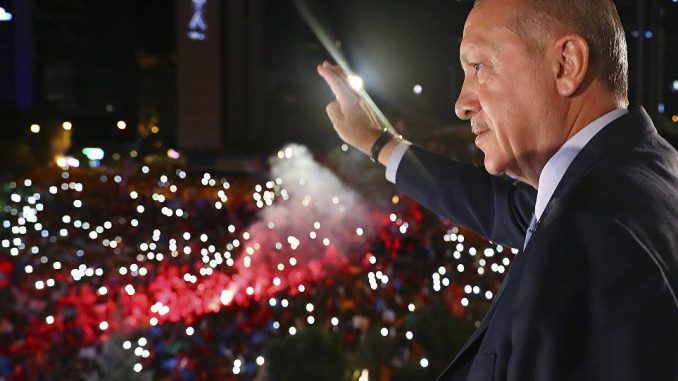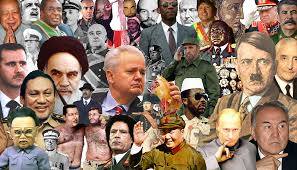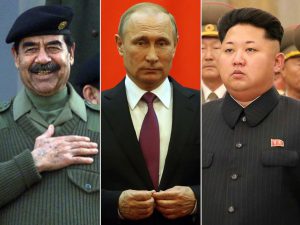
Destroying Democracy is Easier Than You Think
When Americans think of the collapse of a democracy, they typically picture scenes of armed men fighting in the streets. They envision death, ruin and destruction brought to their nation as opposing forces battle over their country’s future.
But, in the modern age, that isn’t the only way free societies fail. In fact, it isn’t even the most common way. History demonstrates this and current day examples of how freedom is lost further illustrate this pattern.
Look at what has happened to Turkey for a better example of how democracies are replaced by dictatorial regimes in the modern age…
The Destruction of Democracy in the Modern Age
Turkey is a NATO member and an advanced economy. Using a referendum in 2017, Turkey effectively stripped parliament of its power and established one-man rule in the country. With its parliament reduced to little more than a rubber stamp for the president and the powerful prime minister position neutered, Recep Erdogan, the country’s defacto dictator, was able to make sweeping reforms of the government to consolidate his power. With the unknowing support of the Turkish people, Erdogan was essentially able to turn his country into a one-party dictatorship. Leaving the appearance of a democracy in place, Erdogan provided his government with the cover that it is acting in the best interest of its people. But, in the process, Erdogan now deprives his own people of the rights they once had.
President Erdogan didn’t use the point of a bayonet to compel the Turkish people to cooperate in the destruction of their democracy. Nor did he achieve his power quickly and obviously. Instead, he compromised citizens by carefully pitting one group of Turks against another. By exploiting his people’s fear of terrorists and outsiders to turn them against his rivals, he then used the power of the government to reward his friends and punish his opponents. It was a simple plan and it convinced a once free people to give up their Rights out of fear. His own people viewed his actions as thwarting demonized enemies to protect them without them noticing their own loss of freedom.
This is how authoritarian leaders slowly transition their countries from democracies to dictatorships. It is also a repeated pattern played out in history from which we can learn. By using the tools of democracy against the system, itself, democracies lose their freedom in the hands of would-be dictators. A review of history or of the demise of Turkey’s freedom tells the story of government used as a means to limit freedom for all under the guise of “helping” or “protecting” its people.
Ten Characteristics of Dictator Tactics:
While each case of a democracy losing its freedom is different, there are, essentially, 10 characteristics each has in common in countries whose democracy eroded into a dictatorship.
1.) Government attempts to intimidate or restrict the media.
Democracies thrive on the free exchange of information independent of government or special interest control. But dictatorships can’t survive alongside a free press. Therefore, in the early stages of establishing control over their people, would-be dictators attempt to suppress or take-over the media. They often broaden libel laws to make it easier to sue or censor the free press. They encourage wealthy allies to acquire media outlets critical of the regime. With outlets owned by political allies, the media will show favoritism, exchanging easy access to the leader and his administration for favorable media coverage. A look at dictators in history shows that control of the free press was part of their take-over of their country.
2.) The creation of a crisis or failure of government to justify taking extreme or emergency measures.

The most famous example of this tactic was the way the Nazi regime used the Reichstag fire of 1933. The fire happened just one month after the election of Adolf Hitler and allowed him to jail their communist party rivals in the German parliament and consolidate their grip on the German state. The Nazis used the fire as an excuse to suspend civil liberties and make mass arrests of their political adversaries.
3.) The use of minorities, immigrants and foreigners as scapegoats.
Blaming a nation’s ills on foreigners or politically weak minorities is a tactic authoritarian regimes have used for ages. Dictators use carefully chosen words designed to dehumanize their targets, treating them as outsiders intent on harming their host country. For example, Hitler compared his chosen scapegoats to animals and called them criminals seeking to “infest” the nation in which they lived. It is important to would-be dictators to create an “us versus them” mentality among the dictator’s supporters. The dictator’s use of a common enemy makes his supporters more willing to take action against these created enemies, which they would not usually take.
4.) Preventing opponents from getting access to resources needed to compete.
Destroying the political opponents of a dictator is easier to accomplish if those opponents no longer have access to the resources they need to be effective. Taking away sources of funding, access to the courts, the ability to assemble in groups or to get their information out before the general public, makes neutering political opponents substantially easier. Dictators of history notoriously attacked potential opponents, outlawing their existence, restricting their ability to meet, and denying them media access.
5.) Undermining the current political system.
To replace an existing system with one more amenable to support a dictator’s rule, the credibility of the existing system must be fatally undermined. Dictators accomplish by creating doubts about the system. They methodically demean, undermine and fault aspects of government. By claiming elections are “rigged” or “unfair to the People” they establish doubt in the existing system. By demeaning those charged with protecting the system’s integrity, the dictator and his supporters erode the confidence the people have in their government. When the dictator has successfully convinced his people their government fails them, the citizens begin to accept changes the dictator promises will better protect them. He can even convince them he can make future elections a more accurate representation of the will of the people.
6.) Expanding the size of the judiciary to stack it with judges sympathetic to the regime.
If it is difficult to replace current sitting judges on the bench when a dictator strives for power, he can remove a judicial obstacle to his control by simply creating more courts to fill with judges who will do the tyrant’s bidding. Once a dictator has more power, removing and replacing sitting judges becomes easier.
7.) Eliminate term limits.
Democracies typically limit the amount of time a president may stay in office. This is done to prevent a leader from accumulating so much power through patronage he is no longer constrained by the system’s checks and balances. Dictators thrive on patronage and need time in office to thoroughly permeate the bureaucracy of the government over which they intend to rule. Once established in power the dictator will want to remain in office and will need to end term limits. Examples of eliminated term limits include China’s Xi Jiping, Chavez of Venezuela, and Marcos of the Philippines.
8.) Suppressing, taking over and intimidating the legislature.
A free, independent and confident legislature willing to take an adversarial role opposed to a dictator is a condition the autocratic ruler cannot tolerate. To prevent this constraint of the leader’s power, dictators use political forces to attack the integrity, honor and even legitimacy of opposing members of the legislature. They punish them by withholding national resources from the legislator’s district and by blaming them for problems the country faces. Potential political opponents are denied Party support, have their support threatened for speaking against the dictator, or can be blocked from access to crucial resources.
9.) Politicizing law enforcement, national security agencies and the military and significantly increasing their size.

One major obstacle preventing a dictator from overthrowing a democracy are the armed men and women serving the nation in uniform. Without their support, a dictator’s ability to consolidate power would be greatly limited. By undermining a uniformed service’s leadership and replacing it with one sympathetic to the dictator, a tyrant’s chances of staying in power replacing the nation’s democracy is vastly improved. Once military leadership is taken over, dictators then consolidate their power by filling the ranks of uniformed services with those loyal to the tyrant.
10.) Using state power to reward the dictator’s friends and to punish his enemies.
Using the treasuries of a nation to reward those propping up a dictator is how autocratic regimes have operated for years. Turkish President Recep Erdogan amassed his power in part by filling the bank accounts of powerful Turks supporting his rise to power at the expense of the Turkish economy.
Russian leader Vladimir Putin pays off his nation’s oligarchs in the same fashion, buying their support for his brutal and illiberal regime.
Conversely, dictators use their nation’s legal and political systems or their government departments to punish those who oppose them. Passing legislation designed to hurt the business of an opponent, for example, is one way tyrants use their governmental power to force opponents to give up resisting their rule.
Patience and Persistence: More Effective Than Tanks
By being patient, by taking their time, by stacking the news outlets and government watchdog groups with those friendly to the government, by relentlessly using the power of the government to harass political opponents until they can no longer resist, by using the police and paramilitary forces to intimidate protestors and jail or attack their leaders, and by accusing the political system, its institutions and the men and women charged with faithfully executing its mission of being corrupt, unethical and partisan, aspiring dictators undermine the foundations of liberty that prevent tyrants from rising to power.
By resisting the impulse to send in the tanks or use violence to overthrow a democracy to force the dictator’s will upon the people, the tyrant still achieves his aim and the outcome is still the same. Patient and persistent tactics, instead of force, delivers the tyrant’s goals. The dictator manages to slowly replace freedom with a dictatorship without citizens really being able to identify the moment when their freedom and their rights ceased to exist. That is how democracy is lost in the modern age.
Photo: Recep Erdogan addressing Turkish citizens
https://www.washingtonpost.com/news/wonk/wp/2018/03/15/a-brief-93-part-history-of-power-grabs-from-ferdinand-marcos-to-xi-jinping/?utm_term=.1c4b1b1badc2



Leave a Reply